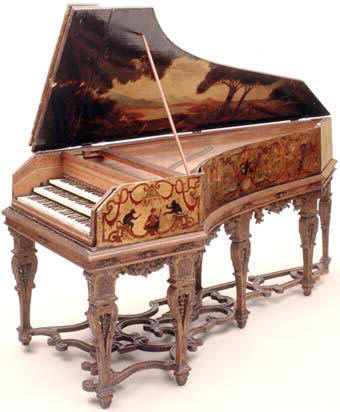![]()
|
Towards establishing the original
state of the three-manual harpsichord by Stefano Bolcioni, Florence, 1627, in
the Russell Collection of Early Keyboard Instruments, Edinburgh an article published in The Galpin Society Journal, 53 (2000)
168-200 by Grant O'Brien |
|
Another method of determining the Florentine soldo from the Edinburgh Bolcioni
harpsichord
Because the use of the Florentine soldo enters into all aspects of the construction of the Bolcioni harpsichord, there are other methods of determining the value of the unit of measurement, and what method is used to make this determination is limited only by the ingenuity and imagination of the investigator. One such method was noted at the time that I was working on the Edinburgh Bolcioni harpsichord discussed in detail above, and involves the regular spacing of the jackslots in the boxslide register. The position of each of the register slots was measured from the original bass end of one of the registers. These are given in Table 1 below and are plotted in the graph shown in Figure 1
|
Note |
Length in mm. |
Note |
Length in mm. |
|
|
c3 |
722.1 |
|
b |
364.3 |
|
b2 |
709.9 |
|
bb |
351.0 |
|
bb2 |
695.9 |
|
a |
337.8 |
|
a2 |
682.7 |
|
aI |
325.0 |
|
g#2 |
669.8 |
|
g# |
311.6 |
|
g2 |
656.3 |
|
g |
298.9 |
|
f#2 |
643.0 |
|
f# |
285.5 |
|
f2 |
629.3 |
|
f |
272.1 |
|
e2 |
616.6 |
|
e |
259.1 |
|
eb2 |
603.4 |
|
eb |
246.0 |
|
d2 |
590.2 |
|
d# |
233.1 |
|
c#2 |
577.0 |
|
d |
220.0 |
|
c2 |
563.7 |
|
c# |
206.4 |
|
b1 |
550.8 |
|
c |
193.7 |
|
bb1 |
537.5 |
|
B |
180.8 |
|
a1 |
524.0 |
|
Bb |
167.2 |
|
ab1 |
510.7 |
|
A |
154.1 |
|
g#1 |
497.7 |
|
G# |
141.4 |
|
g1 |
484.2 |
|
E |
128.1 |
|
f#1 |
470.8 |
|
G |
115.6 |
|
f1 |
457.2 |
|
F# |
102.7 |
|
e1 |
444.1 |
|
D |
90.0 |
|
eb1 |
430.7 |
|
F |
77.2 |
|
d#1 |
417.7 |
|
C |
64.8 |
|
d1 |
403.9 |
|
[A1] |
52.4 |
|
c#1 |
390.2 |
|
[G1] |
39.4 |
Table 1 - Distance in mm from the original bass end of the front boxslide register to the bass edge of each of its jackslots
Three-manual
harpsichord by Stefano Bolcioni, Florence, 1627
Russell Collection
of Early Keyboard Instruments, Cat. No. HT1-SB1627.4

Figure 1 - Graph of the distance from the original bass end of the front boxslide register to the bass edge of each of its jackslots
Three-manual
harpsichord by Stefano Bolcioni, Florence, 1627
Russell Collection
of Early Keyboard Instruments, Cat. No. HT1-SB1627.4
The graph of Figure 1 is clearly a straight line and, since both axes are linear in scale, the slope and the intercept can be calculated for this line. The use of the method of least squares and the usual regression analysis enables an accurate and unbiased determination of these two factors. This has been done and the slope of the line is found to be 13.1815mm per slot. Using the value of the soldo already calculated for this instrument of 27.345mm from the section on the analysis of the unit of measurement, this is equivalent to 0.4820 soldi per slot. This does not correspond to an exact, simple number of soldi per single register slot, but it does correspond to 24.10 soldi in a width of 50 jackslots. This strongly suggests that Bolcioni intended 50 jackslots to have a width of exactly 24 soldi[1]. Assuming this to be the case then the slope of the graph should, in theory, be exactly 0.480 soldi per jackslot:
Slope = 13.1815![]() =
=
![]() = 0.480
= 0.480![]()
Hence:
1 soldo =
![]() = 27.46mm
= 27.46mm
The braccio with 20 soldi as used by Bolcioni would therefore have a length of 549.23mm. This is only about 0.2% different from the braccio given in the reference in footnote 7 in the Introduction. of 550.6371mm (1 soldo = 27.53mm since 1 braccio = 20 soldi). If it is assumed that there was an error in the measurement of the position of each of the register slots of 0.1mm and that Bolcioni made about this same error when he cut the register slots, then, if my assumptions about the separation of the jackslots chosen by Bolcioni is correct, the value of the soldo determined from the regression analysis of the slope of the graph shown in Figure 1 has an error of only 0.08% or 0.02mm. Hence the size of the soldo used by Bolcioni has been determined by this method to an extremely high degree of accuracy. The use of this method has been found to apply in other instruments[2] and points the way to other methods of determining the size of the local unit of measurement, or of refining it.
